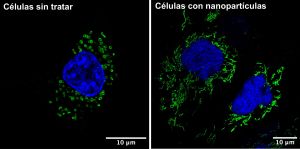“Ahora hemos visto que las propias nanopartículas y las moléculas de las que se recubren para su uso biomédico pueden tener efectos antitumorales. Estas nanopartículas son como “nanocanicas sólidas” explica Domingo F Barber, investigador en el CNB-CSIC que ha liderado el trabajo. “Tienen un núcleo compacto de óxido de hierro que hay recubrir con diferentes materiales para proporcionar así más estabilidad y menos toxicidad. Nuestro grupo lleva años analizando diferentes tipos de recubrimiento y viendo cómo afectan a su entrada en la célula, su acumulación y degradación dentro de la misma, pero hasta ahora no habíamos estudiado su efecto en el metabolismo celular a nivel global”.
El investigador señala “sabíamos también que las nanopartículas pueden aumentar el estrés oxidativo celular sin afectar de manera considerable al equilibrio a determinadas dosis. Ahora nos preguntamos si algún tipo de recubrimiento podría potenciar aún más el estrés en células tumorales, donde la homeóstasis ya está desregulada, hasta niveles que conlleven la muerte celular de manera selectiva.”
Neus Daviu, también investigadora del CNB-CSIC detalla el análisis realizado “hemos utilizado tres tipos de recubrimientos diferentes en las nanopartículas y probado si afectan al metabolismo celular tanto en líneas celulares modelo de diferentes tipos de tumor (mama, páncreas y glioma) como en líneas no tumorales de macrófagos y células endoteliales que también se pueden encontrar en los tumores.”
Los parámetros estudiados son varios. Por un lado la actividad metabólica de la célula, analizando el funcionamiento de las mitocondrias, el orgánulo encargado de la respiración. No solo cambian su forma, un síntoma claro de mal funcionamiento si no que también producen menos ATP, la molécula esencial para producir energía, y se degradan más, ya que la célula detecta que funciona mal y las elimina en un proceso llamado autofagia. Además, continua Daviu, “se produce una parada en el ciclo celular: las células tumorales tratadas con las nanopartículas cubiertas con DMSA (ácido dimercaptosucinico) crecen mucho menos, se quedan como “atascadas/atoradas”, un efecto muy deseado para frenar la proliferación de los tumores.”
Las nanopartículas mejoran el resultado del tratamiento antitumoral tanto in vitro e in vivo
Los investigadores destacan el efecto diferencial en los distintos tipos celulares de tumor utilizados, siendo los más sensibles al efecto de estas nanopartículas los de origen mamario. Aunque estos datos se han obtenido en líneas celulares, otros trabajos de los mismos autores apuntan a un mejor funcionamiento in vivo (en ratones) de la terapia antitumoral cuando se administra a través de nanopartículas recubiertas con DMSA, lo que remarca su potencial para el transporte dirigido de fármacos y su colaboración en la reducción de los tumores.
Más información
Neus Daviu, Yadileiny Portilla, Marta Gómez de Cedrón, Ana Ramírez de Molina, Domingo F. Barber. DMSA-coated IONPs trigger oxidative stress, mitochondrial metabolic reprograming and changes in mitochondrial disposition, hindering cell cycle progression of cancer cells. Biomaterials 2024; https://doi.org/10.1016/j.biomaterials.2023.122409






